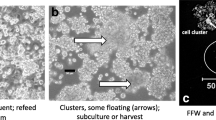Abstract
Removal of Wolbachia from infected insects is required in most experimental settings when the effects of Wolbachia on biological traits, pathogen blocking, reproduction, and fitness are assessed. This is to ensure that the genetic backgrounds of Wolbachia-infected and uninfected insects are the same. Here, we describe methodologies used for the elimination of Wolbachia from insects and insect cell lines with antibiotics.
Access this chapter
Tax calculation will be finalised at checkout
Purchases are for personal use only
Similar content being viewed by others
References
Zug R, Hammerstein P (2012) Still a host of hosts for Wolbachia: analysis of recent data suggests that 40% of terrestrial arthropod species are infected. PLoS One 7:e38544. https://doi.org/10.1371/journal.pone.0038544
Gomes TMFF, Wallau GL, Loreto ELS (2022) Multiple long-range host shifts of major Wolbachia supergroups infecting arthropods. Sci Rep 12:8131. https://doi.org/10.1038/s41598-022-12299-x
Kaur R, Shropshire JD, Cross KL et al (2021) Living in the endosymbiotic world of Wolbachia: a centennial review. Cell Host Microbe 29:879–893. https://doi.org/10.1016/j.chom.2021.03.006
Johnson KN (2015) The impact of Wolbachia on virus infection in mosquitoes. Viruses 7:5705–5717. https://doi.org/10.3390/v7112903
Moreira LA, Iturbe-Ormaetxe I, Jeffery JA et al (2009) A Wolbachia symbiont in Aedes aegypti limits infection with Dengue, Chikungunya, and Plasmodium. Cell 139:1268–1278. https://doi.org/10.1016/j.cell.2009.11.042
Ballard JWO, Melvin RG (2007) Tetracycline treatment influences mitochondrial metabolism and mtDNA density two generations after treatment in Drosophila. Insect Mol Biol 16:799–802. https://doi.org/10.1111/j.1365-2583.2007.00760.x
Li Y-Y, Fields PG, Pang B-P et al (2016) Effects of tetracycline and rifampicin treatments on the fecundity of the Wolbachia -infected host, Tribolium confusum (Coleoptera: Tenebrionidae). J Econ Entomol 109:1458–1464. https://doi.org/10.1093/jee/tow067
Chopra I, Roberts M (2001) Tetracycline antibiotics: mode of action, applications, molecular biology, and epidemiology of bacterial resistance. Microbiol Mol Biol Rev 65:232–260. https://doi.org/10.1128/MMBR.65.2.232-260.2001
Wangkeeree J, Suwanchaisri K, Roddee J et al (2022) Selective elimination of Wolbachia from the leafhopper Yamatotettix flavovittatus Matsumura. Curr Microbiol 79:173. https://doi.org/10.1007/s00284-022-02822-8
Li Y, Liu X, Guo H (2019) Population dynamics of Wolbachia in Laodelphax striatellus (Fallén) under successive stress of antibiotics. Curr Microbiol 76:1306–1312. https://doi.org/10.1007/s00284-019-01762-0
Pfaffl MW (2001) A new mathematical model for relative quantification in real-time RT-PCR. Nucleic Acids Res 29:e45. https://doi.org/10.1093/nar/29.9.e45
Moullan N, Mouchiroud L, Wang X et al (2015) Tetracyclines disturb mitochondrial function across eukaryotic models: a call for caution in biomedical research. Cell Rep 10:1681–1691. https://doi.org/10.1016/j.celrep.2015.02.034
Acknowledgements
SA has been supported by the Australian Research Council Discovery projects (DP180101669 and DP210101791).
Author information
Authors and Affiliations
Corresponding author
Editor information
Editors and Affiliations
Rights and permissions
Copyright information
© 2024 The Author(s), under exclusive license to Springer Science+Business Media, LLC, part of Springer Nature
About this protocol
Cite this protocol
Bishop, C., Asgari, S. (2024). Use of Antibiotics to Eliminate Wolbachia from Mosquitoes and Cell Culture. In: Fallon, A.M. (eds) Wolbachia. Methods in Molecular Biology, vol 2739. Humana, New York, NY. https://doi.org/10.1007/978-1-0716-3553-7_9
Download citation
DOI: https://doi.org/10.1007/978-1-0716-3553-7_9
Published:
Publisher Name: Humana, New York, NY
Print ISBN: 978-1-0716-3552-0
Online ISBN: 978-1-0716-3553-7
eBook Packages: Springer Protocols




